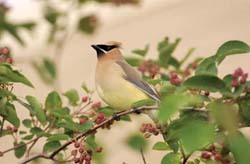BIRD OF THE MONTH: CEDAR WAXWING
Cedar Waxwings are medium-sized, sleek birds with large heads, short necks and short, wide bills. They have a crest that often lies flat or droops over the back of the head. The wings are broad and pointed. Their tail is fairly short and square-tipped.
Cedar Waxwings are colorful bird with silky, shiny feathers of brown, gray and lemon-yellow. They boast rakish black masks, brilliant red "wax" droplets on the wing feathers, and a flash of bright yellow across the tips of their tails.
Cedar Waxwings are social birds that form large flocks and often nest in loose clusters of a dozen or so nests. Unlike other birds that separate out seeds and regurgitate them, when feeding on fruits Cedar Waxwings pluck them one by one and swallow the entire thing at once. When eating insects, waxwings either fly out from an exposed perch, or make long, zig-zagging flights over water. During courtship, males and females hop towards each other, alternating back and forth and sometimes touching their bills together. Males often pass a small item like a fruit, insect, or flower petal to the female. After taking the "gift", the female usually hops away and then returns giving back the item to the male. They repeat this a few times until the female eats the item.
Cedar Waxwings love fruit and feed on it year-round. In summer, they eat serviceberry, strawberry, mulberry, dogwood and raspberries. They eat cedar berries in winter hence the name. They also eat mistletoe, madrone, juniper, mountain ash, honeysuckle, crabapple and hawthorne and supplement their diet with protein-rich insects.
The name "waxwing" comes from the waxy red secretions found on the tips of the secondaries of some birds. The exact function of these tips is not known, but they may help attract mates.
Female waxwings do almost all the next building. She builds a bulky cup about 5 inches across and 3 inches high out of twigs, grasses, cattail down, blossoms, string, horsehair and similar materials. Building the nest can take up to 5 or 6 days and may require more than 2,500 individual trips to the nest. It is typically built on the fork of a horizontal tree branch anywhere from 3 to 50 feet in the air.
The female will lay 2 - 6 eggs that are pale blue or blue gray sometimes spotted with black or gray. Incubation lasts 11 - 13 days and the new babies are naked, blind, helpless, weak and quiet. They will fledge in 14 - 18 days.
Look for Cedar Waxwings in deciduous, coniferous and mixed woodlands, particularly in areas along streams. They can also be found in old fields, grasslands, sagebrush and even along desert washes. In winter, Cedar Waxwings are most abundant around fruiting plants in open woodlands, parks, gardens, forest edges and second-growth forest.

